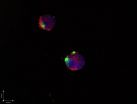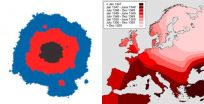IBS is managed effectively with the right drugs, for the right symptoms
New American Gastroenterological Association guidelines provide guidance on treatments
2014-11-05
(Press-News.org) Bethesda, MD (Nov. 5, 2014) — Up to 15 percent of the general adult population is affected by irritable bowel syndrome (IBS), and most patients struggle to find effective drug therapy. A new guideline from the American Gastroenterological Association (AGA) provides these patients and their physician's guidance. The new guideline and accompanying technical review have been published in Gastroenterology, the official journal of the AGA Institute.
"Because no IBS therapy is uniformly effective, many patients describe a history of a variety of treatments alone or in combination. This guideline will help patients and physicians navigate the drug options. It's also important to consider other clinically relevant information, such as a patient's values and preferences, when making treatment decisions," said Shahnaz Sultan, MD, MHSc, an author of the guidelines, from the gastroenterology section, Department of Veteran Affairs Medical Center, North Florida/South Georgia Veterans Health System.
The AGA developed the guideline using Grading of Recommendations Assessment, Development and Evaluation (GRADE) methodology2 and best practices as outlined by the Institute of Medicine. Despite a large number of published studies on IBS therapies, in most cases, the quality of available data and or the balance of risks and benefits for a particular therapy did not overwhelmingly support the use of particular drugs. Additionally, there are no studies comparing the effectiveness of commonly used drugs to each other nor is there data comparing combinations of therapies to placebo or to each other.
Recognizing these limitations, the AGA Institute guidelines represent a rigorous, evidenced-based summary of extensive literature describing the use of drug treatments for IBS.
Patients with IBS-C (constipation)
Recommends using linaclotide (over no drug treatment) in patients with IBS-C. (Strong recommendation; High-quality evidence)
Suggests using lubiprostone (over no drug treatment) in patients with IBS-C. (Conditional recommendation; Moderate-quality evidence)
Suggests using lubiprostone (over no drug treatment) in patients with IBS-C. (Conditional recommendation; Moderate-quality evidence)
Patients with IBS-D (diarrhea)
Suggests using rifaximin (over no drug treatment) in patients with IBS–D. (Conditional recommendation; Moderate-quality evidence)
Suggests using alosetron (over no drug treatment) in patients with IBS-D to improve global symptoms. (Conditional recommendation; Moderate evidence)
Suggests using loperamide (over no drug treatment) in patients with IBS-D. (Conditional recommendation; Very low-quality evidence)
Patients with IBS
Suggests using tricyclic antidepressants (over no drug treatment) in patients with IBS. (Conditional recommendation; Low-quality evidence)
Suggests against using selective serotonin reuptake inhibitors for patients with IBS. (Conditional recommendation; Low-quality evidence)
Suggests using antispasmodics (over no drug treatment) in patients with IBS. (Conditional recommendation; Low-quality evidence)
INFORMATION:
Read the "American Gastroenterological Association Institute Guideline on the Use of Pharmacological Therapies in the Treatment of Irritable Bowel Syndrome" to review the treatment recommendations in its entirety.
To learn more about IBS, read the AGA patient brochure at http://www.gastro.org/patient-center/digestive-conditions/irritable-bowel-syndrome.
AGA's guidelines are created using a process that employs the Grading of Recommendations Assessment, Development and Evaluation (GRADE) methodology. GRADE has been adopted by several national and international societies, including the AGA, and is becoming the common methodology for the streamlined and rigorous development of clear, transparent and actionable guidelines.
1 Weinberg D S J P. American Gastroenterological Association Institute Guideline on the Use of Pharmacological Therapies in the Treatment of Irritable Bowel Syndrome. Gastroenterology 2014;147(5):1146-1148.
Chang L et al. American Gastroenterological Association Institute Technical Review on the Pharmacological Management of Irritable Bowel Syndrome. Gastroenterology 2014; 147(5):1149–1172.e2
About the AGA Institute
The American Gastroenterological Association is the trusted voice of the GI community. Founded in 1897, the AGA has grown to include 17,000 members from around the globe who are involved in all aspects of the science, practice and advancement of gastroenterology. The AGA Institute administers the practice, research and educational programs of the organization. http://www.gastro.org.
About Gastroenterology
Gastroenterology, the official journal of the AGA Institute, is the most prominent scientific journal in the specialty and is in the top 1 percent of indexed medical journals internationally. The journal publishes clinical and basic science studies of all aspects of the digestive system, including the liver and pancreas, as well as nutrition. The journal is abstracted and indexed in Biological Abstracts, Current Awareness in Biological Sciences, Chemical Abstracts, Current Contents, Excerpta Medica, Index Medicus, Nutrition Abstracts and Science Citation Index. For more information, visit http://www.gastrojournal.org.
Like AGA and Gastroenterology on Facebook.
Join AGA on LinkedIn.
Follow us on Twitter @AmerGastroAssn.
Check out our videos on YouTube.
ELSE PRESS RELEASES FROM THIS DATE:
2014-11-05
What sounds counter-intuitive to an activity commonly perceived as quiet is the broad recommendation of scientists at Michigan State University (MSU) recommending that small-scale fishing in the world's freshwater bodies must have a higher profile to best protect global food security.
In this month's journal Global Food Security, scientists note that competition for freshwater is ratcheting up all over the world for municipal use, hydropower, industry, commercial development, and irrigation. Rivers are being dammed and rerouted, lakes and wetlands are being drained, fish ...
2014-11-05
Noonan syndrome is a rare disease that is characterised by a set of pathologies, including heart, facial and skeletal alterations, pulmonary stenosis, short stature, and a greater incidence of haematological problems (mainly juvenile myeloid leukaemia, or childhood leukaemia). There is an estimated incidence of 1 case for every 1,000–2,500 births, and calculations show some 20,000–40,000 people suffer from the disease in Spain. From a genetic point of view, this syndrome is associated to mutations in 11 different genes —the K-Ras gene among them— ...
2014-11-05
PATIENTS with a specific type of oesophageal cancer survived longer when they were given the latest lung cancer drug, according to trial results being presented at the National Cancer Research Institute (NCRI) Cancer Conference today (Wednesday).
Up to one in six patients with oesophageal cancer were found to have EGFR duplication in their tumour cells and taking the drug gefitinib, which targets this fault, boosted their survival by up to six months, and sometimes beyond.
This is the first treatment for advanced oesophageal cancer shown to improve survival in patients ...
2014-11-05
Fatih Uckun, Jianjun Cheng and their colleagues have taken the first steps towards developing a so-called "smart bomb" to attack the most common and deadly form of childhood cancer — called B-lineage acute lymphoblastic leukemia (ALL).
In a November study in the new peer-reviewed, open-access journal EBioMedicine, they describe how this approach could eventually prove lifesaving for children who have relapsed after initial chemotherapy and face a less than 20 percent chance of long-term survival.
"We knew that we could kill chemotherapy-resistant leukemia cells ...
2014-11-05
The current Ebola outbreak shows how quickly diseases can spread with global jet travel.
Yet, knowing how to predict the spread of these epidemics is still uncertain, because the complicated models used are not fully understood, says a University of California, Berkeley biophysicist.
Using a very simple model of disease spread, Oskar Hallatschek, assistant professor of physics, proved that one common assumption is actually wrong. Most models have taken for granted that if disease vectors, such as humans, have any chance of "jumping" outside the initial outbreak area ...
2014-11-05
Researchers using a new type of tracking device on female elephant seals have discovered that adding body fat helps the seals dive more efficiently by changing their buoyancy.
The study, published November 5 in the Proceedings of the Royal Society B, looked at the swimming efficiency of elephant seals during their feeding dives and how that changed in the course of months-long migrations at sea as the seals put on more fat. The results showed that when elephant seals are neutrally buoyant--meaning they don't float up or sink down in the water--they spend less energy ...
2014-11-05
A University of Oregon researcher wants those "R" words to resonate among young athletes. They are key terms used in an online educational tool designed to teach coaches, educators, teens and parents about concussions.
Brain 101: The Concussion Playbook successfully increased knowledge and attitudes related to brain injuries among students and parents in a study that compared its use in 12 high schools with the usual care practices of 13 other high schools during the fall 2011 sports season. The findings are online ahead of print in the Journal of Adolescent Health.
Participants, ...
2014-11-05
A study led by a researcher from Plymouth University in the UK, has discovered that the inhibition of a particular mitochondrial fission protein could hold the key to potential treatment for Parkinson's Disease (PD).
The findings of the research are published today, 5th November 2014, in Nature Communications.
PD is a progressive neurological condition that affects movement. At present there is no cure and little understanding of why some people get the condition. In the UK one on 500 people, around 127,000, have PD.
The debilitating movement symptoms of the disease ...
2014-11-05
ANN ARBOR, Mich. — Millions of people with diabetes take medicine to ease the shooting, burning nerve pain that their disease can cause. And new research suggests that no matter which medicine their doctor prescribes, they'll get relief.
But some of those medicines cost nearly 10 times as much as others, apparently with no major differences in how well they ease pain, say a pair of University of Michigan Medical School experts in a new commentary in the Annals of Internal Medicine.
That makes cost -- not effect -- a crucial factor in deciding which medicine ...
2014-11-05
TALLAHASSEE, Fla. — A new study by a Florida State University researcher reveals that a new dietary supplement is superior to calcium and vitamin D when it comes to bone health.
Over 12 months, Bahram H. Arjmandi, Margaret A. Sitton Professor in the Department of Nutrition, Food and Exercise Sciences and Director of the Center for Advancing Exercise and Nutrition Research on Aging (CAENRA) at Florida State, studied the impact of the dietary supplement KoACT® versus calcium and vitamin D on bone loss. KoACT is a calcium-collagen chelate, a compound containing ...
LAST 30 PRESS RELEASES:
[Press-News.org] IBS is managed effectively with the right drugs, for the right symptoms
New American Gastroenterological Association guidelines provide guidance on treatments






